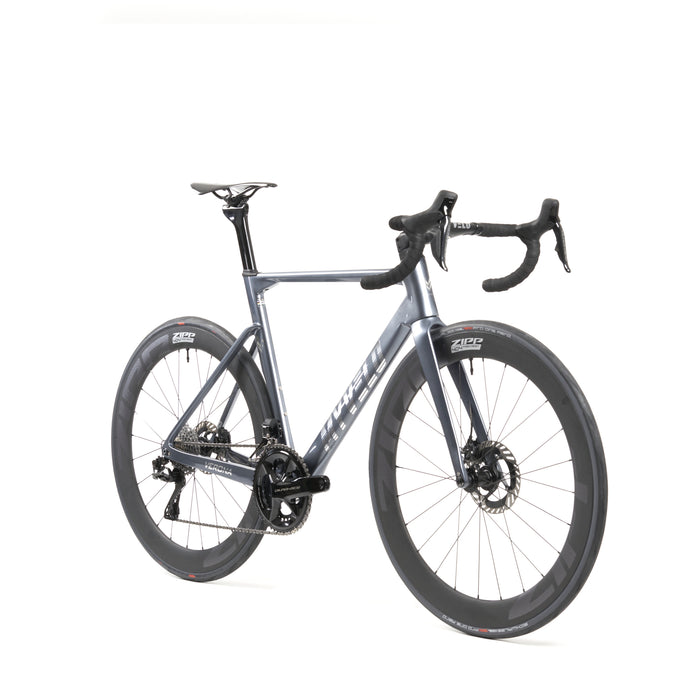
Verona road bike
incl. FREE shipping & free returns

Sprint interval training (SIT) is one of the most effective methods for improving cycling performance. Short, high-intensity sprints with long recovery periods optimize both aerobic and anaerobic capacity.
Von Fabian Huber |
2 minutes read time

SIT offers enormous potential, especially for road cyclists who want to improve their sprinting ability or VO2max.
Sprint interval training involves extremely intense bursts of exercise, usually between 10 and 30 seconds, followed by comparatively long recovery phases of up to four minutes. This type of training differs from classic interval training (HIIT) in that the bursts of exercise are even shorter but maximally intense.
Typical SIT unit:
4-6 sprints of 20 seconds each at maximum intensity
3-4 minutes recovery between sprints
Total duration: approx. 20-30 minutes including entry and exit

SIT requires little training time but delivers comparable or even better results than traditional endurance training methods.
Sprint intervals increase maximum oxygen uptake (VO2max) and thus endurance performance. Studies show that even short SIT sessions can significantly improve aerobic capacity.
Because SIT repeatedly brings the body into the anaerobic zone, the ability to tolerate and clear lactate improves. This is essential for tough road cycling races and sprint finishes.
The short, high-intensity loads specifically train the explosive power of the leg muscles and ensure a better top speed.
SIT creates a strong afterburn effect that increases calorie consumption for hours after training.
Sprint interval training is a great complement to classic core endurance and interval training. Here are some ways you can incorporate SIT into your training:
Once a week as the main training session: Instead of a long ride, a SIT session can be scheduled on a fresh day of the week.
At the end of an easy ride: 2-3 sprints at the end of a training session can improve sprinting ability.
Combined with longer intervals: SIT can be used as a supplement to longer intervals to specifically increase anaerobic capacity.

A good warm-up is mandatory: A warm-up of at least 10 minutes is essential to avoid injuries.
Full intensity: Each sprint must be performed with maximum effort to achieve the desired training effect.
Use long recovery breaks: The breaks between sprints are deliberately longer so that each sprint can be completed with full power.
Not too often: Two SIT sessions per week are sufficient for most drivers.
Pay attention to nutrition and regeneration: High-intensity exercise requires good regeneration, so adequate carbohydrate intake and sleep are important.
Sprint interval training is a highly effective method for achieving maximum performance gains in a short amount of time. Anyone who wants to improve their anaerobic capacity, VO2 max, and sprint power should incorporate SIT into their training plan. Correct implementation is crucial: full intensity in sprints, sufficiently long rest periods, and not too frequent training to avoid overload. Those who incorporate SIT regularly will be able to push those crucial extra watts in the final sprint or during hard attacks in a race.

Radfahren steht für Freiheit, Ausdauer und mentale Stärke. Doch gerade Frauen kennen auch die Schattenseite des Sports – wenn der Intimbereich nach langen Touren schmerzt, taub wird oder einfach nur brennt. Themen wie Reibung, Druckstellen oder Schwellungen sind tabu, aber sie betreffen viele. Zeit also, ehrlich darüber zu sprechen, wie Radfahren den weiblichen Intimbereich beeinflusst – und was wirklich hilft.

Gravelbikes sind in den letzten Jahren zu echten Allroundern auf dem Fahrradmarkt geworden. Sie kombinieren die Sportlichkeit eines Rennrads mit der Robustheit eines Mountainbikes und sind ideal für alle, die sowohl auf Asphalt als auch auf Schotterwegen unterwegs sein wollen. Doch gerade Einsteiger stellen sich oft die Frage: Bekommt man ein gutes, modernes Gravelbike schon für unter 1000 Euro? Die Antwort lautet: Ja – wenn man weiß, worauf es ankommt.

Wer viel Rennrad fährt, kennt das Gefühl: Anfangs ist alles wunderbar – der Wind pfeift, die Beine laufen, die Strecke ist dein Element. Doch nach einer Stunde meldet sich dein Hintern. Erst leicht, dann stechend, schließlich so brennend, dass jeder Tritt zur Qual wird. Willkommen im Club: Satteldruck und gereizte Haut gehören zu den häufigsten Beschwerden unter Radfahrer*innen – und kaum jemand spricht offen darüber.
Zeit, das Tabu zu brechen.